BMW Group: Global Expansion Strategies, Risks, and Opportunities
VerifiedAdded on 2019/09/18
|14
|3424
|315
Report
AI Summary
This report provides a comprehensive analysis of BMW's global expansion strategy, examining the company's approach to international markets, its strengths and weaknesses, and the opportunities and threats it faces. The report explores the impact of globalization on BMW, including the benefits of expanding into new markets, accessing cheaper resources, and fostering international development. It also delves into the internal and external factors influencing BMW's business, such as brand image, competition, and economic conditions. The analysis includes a SWOT analysis of BMW, highlighting its brand reputation, product quality, and skilled workforce, as well as its high cost structure and premium pricing. Furthermore, the report considers the political, economic, social, and technological (PEST) factors affecting BMW's operations. Overall, the report offers insights into BMW's competitive model and its ability to navigate the complexities of the global business environment, providing a detailed overview of its strategic choices and performance.
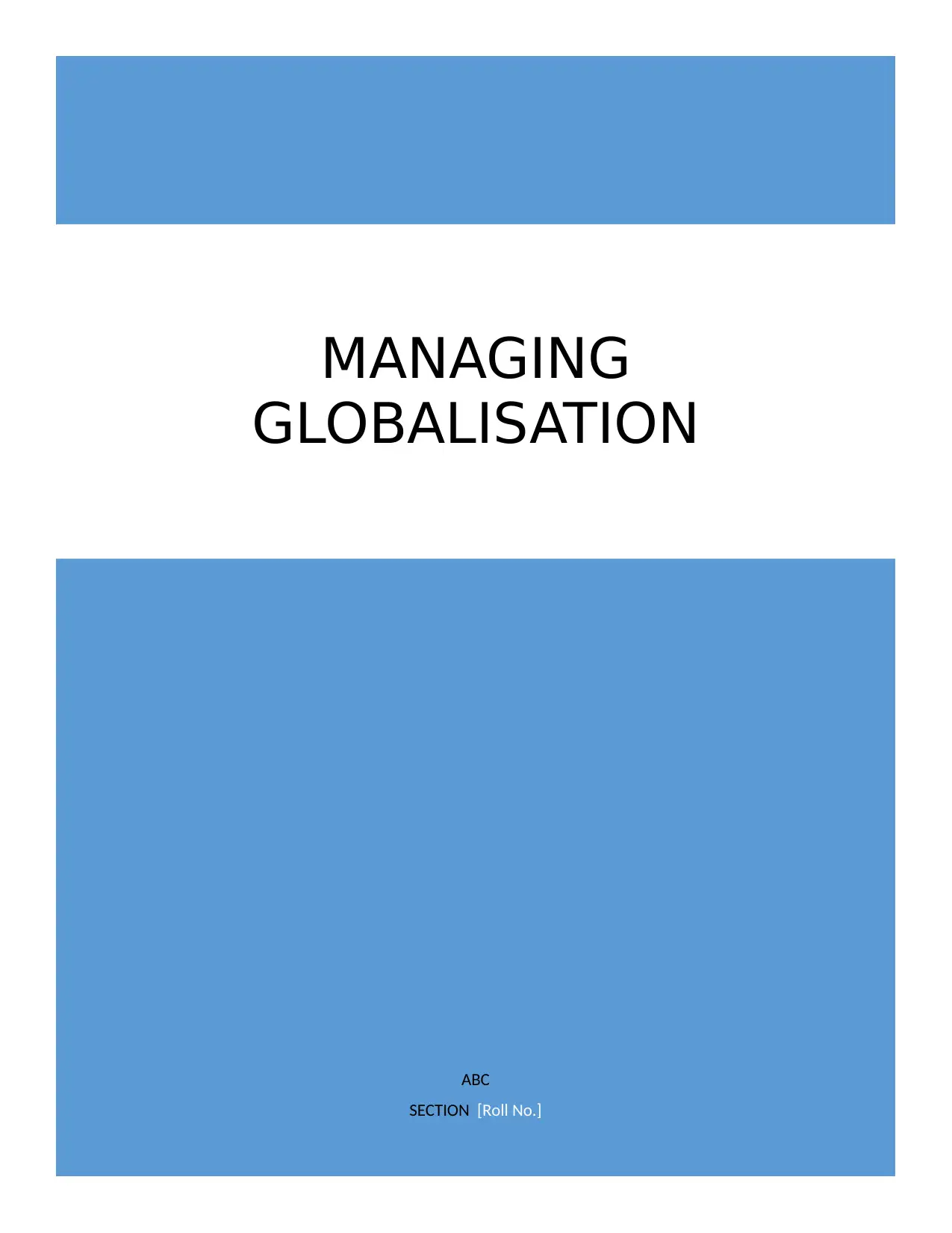
ABC
SECTION [Roll No.]
MANAGING
GLOBALISATION
SECTION [Roll No.]
MANAGING
GLOBALISATION
Paraphrase This Document
Need a fresh take? Get an instant paraphrase of this document with our AI Paraphraser
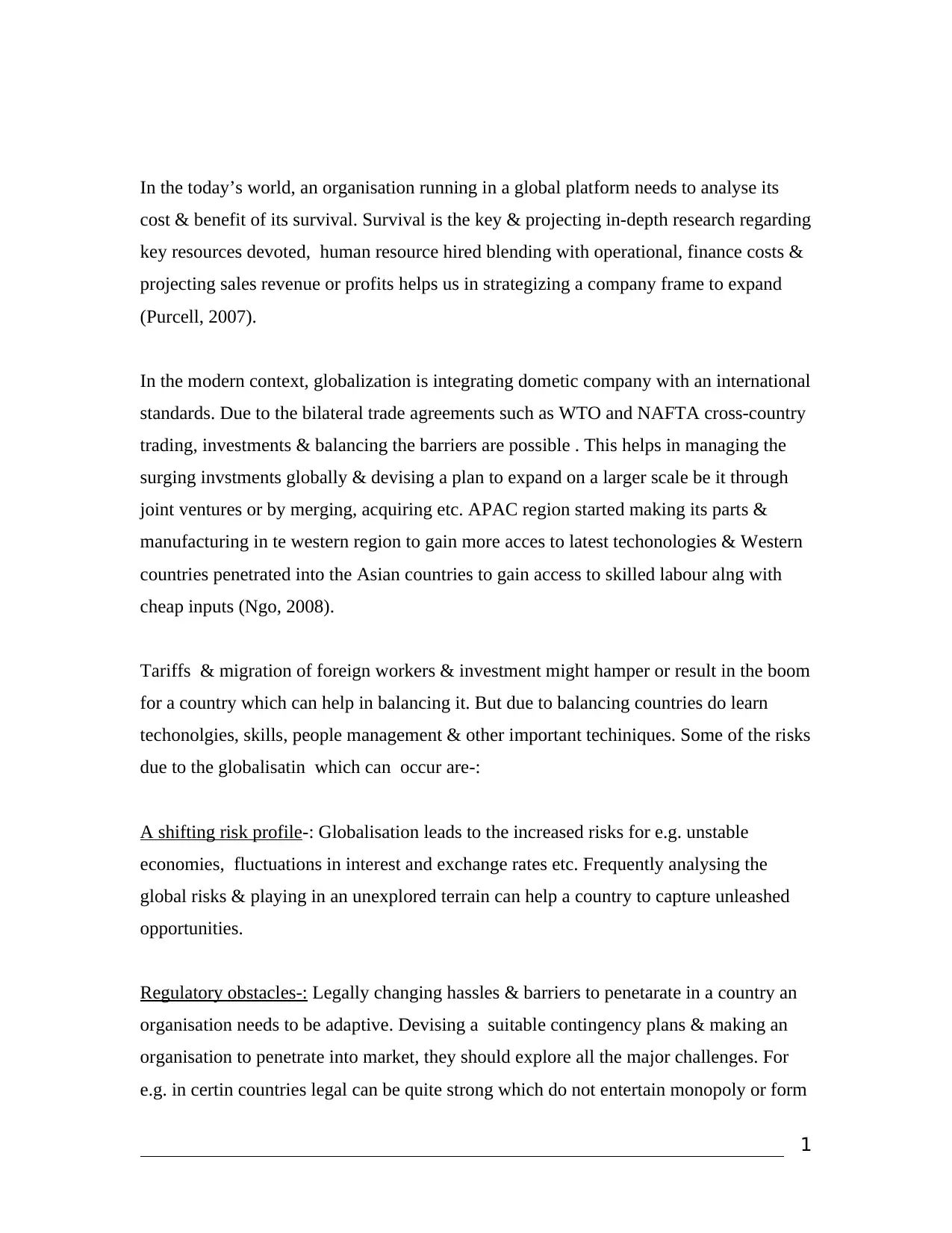
In the today’s world, an organisation running in a global platform needs to analyse its
cost & benefit of its survival. Survival is the key & projecting in-depth research regarding
key resources devoted, human resource hired blending with operational, finance costs &
projecting sales revenue or profits helps us in strategizing a company frame to expand
(Purcell, 2007).
In the modern context, globalization is integrating dometic company with an international
standards. Due to the bilateral trade agreements such as WTO and NAFTA cross-country
trading, investments & balancing the barriers are possible . This helps in managing the
surging invstments globally & devising a plan to expand on a larger scale be it through
joint ventures or by merging, acquiring etc. APAC region started making its parts &
manufacturing in te western region to gain more acces to latest techonologies & Western
countries penetrated into the Asian countries to gain access to skilled labour alng with
cheap inputs (Ngo, 2008).
Tariffs & migration of foreign workers & investment might hamper or result in the boom
for a country which can help in balancing it. But due to balancing countries do learn
techonolgies, skills, people management & other important techiniques. Some of the risks
due to the globalisatin which can occur are-:
A shifting risk profile-: Globalisation leads to the increased risks for e.g. unstable
economies, fluctuations in interest and exchange rates etc. Frequently analysing the
global risks & playing in an unexplored terrain can help a country to capture unleashed
opportunities.
Regulatory obstacles-: Legally changing hassles & barriers to penetarate in a country an
organisation needs to be adaptive. Devising a suitable contingency plans & making an
organisation to penetrate into market, they should explore all the major challenges. For
e.g. in certin countries legal can be quite strong which do not entertain monopoly or form
1
cost & benefit of its survival. Survival is the key & projecting in-depth research regarding
key resources devoted, human resource hired blending with operational, finance costs &
projecting sales revenue or profits helps us in strategizing a company frame to expand
(Purcell, 2007).
In the modern context, globalization is integrating dometic company with an international
standards. Due to the bilateral trade agreements such as WTO and NAFTA cross-country
trading, investments & balancing the barriers are possible . This helps in managing the
surging invstments globally & devising a plan to expand on a larger scale be it through
joint ventures or by merging, acquiring etc. APAC region started making its parts &
manufacturing in te western region to gain more acces to latest techonologies & Western
countries penetrated into the Asian countries to gain access to skilled labour alng with
cheap inputs (Ngo, 2008).
Tariffs & migration of foreign workers & investment might hamper or result in the boom
for a country which can help in balancing it. But due to balancing countries do learn
techonolgies, skills, people management & other important techiniques. Some of the risks
due to the globalisatin which can occur are-:
A shifting risk profile-: Globalisation leads to the increased risks for e.g. unstable
economies, fluctuations in interest and exchange rates etc. Frequently analysing the
global risks & playing in an unexplored terrain can help a country to capture unleashed
opportunities.
Regulatory obstacles-: Legally changing hassles & barriers to penetarate in a country an
organisation needs to be adaptive. Devising a suitable contingency plans & making an
organisation to penetrate into market, they should explore all the major challenges. For
e.g. in certin countries legal can be quite strong which do not entertain monopoly or form
1
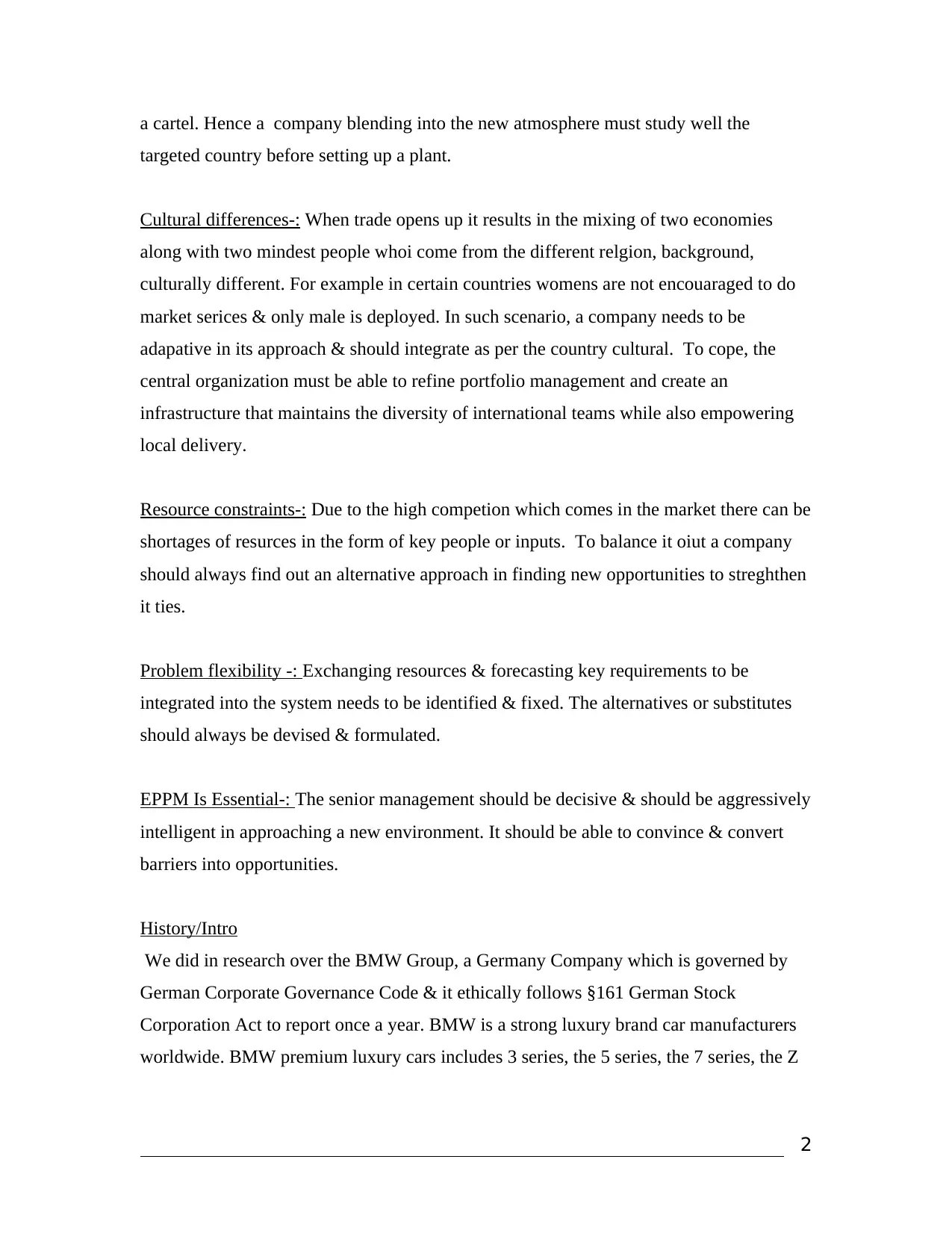
a cartel. Hence a company blending into the new atmosphere must study well the
targeted country before setting up a plant.
Cultural differences-: When trade opens up it results in the mixing of two economies
along with two mindest people whoi come from the different relgion, background,
culturally different. For example in certain countries womens are not encouaraged to do
market serices & only male is deployed. In such scenario, a company needs to be
adapative in its approach & should integrate as per the country cultural. To cope, the
central organization must be able to refine portfolio management and create an
infrastructure that maintains the diversity of international teams while also empowering
local delivery.
Resource constraints-: Due to the high competion which comes in the market there can be
shortages of resurces in the form of key people or inputs. To balance it oiut a company
should always find out an alternative approach in finding new opportunities to streghthen
it ties.
Problem flexibility -: Exchanging resources & forecasting key requirements to be
integrated into the system needs to be identified & fixed. The alternatives or substitutes
should always be devised & formulated.
EPPM Is Essential-: The senior management should be decisive & should be aggressively
intelligent in approaching a new environment. It should be able to convince & convert
barriers into opportunities.
History/Intro
We did in research over the BMW Group, a Germany Company which is governed by
German Corporate Governance Code & it ethically follows §161 German Stock
Corporation Act to report once a year. BMW is a strong luxury brand car manufacturers
worldwide. BMW premium luxury cars includes 3 series, the 5 series, the 7 series, the Z
2
targeted country before setting up a plant.
Cultural differences-: When trade opens up it results in the mixing of two economies
along with two mindest people whoi come from the different relgion, background,
culturally different. For example in certain countries womens are not encouaraged to do
market serices & only male is deployed. In such scenario, a company needs to be
adapative in its approach & should integrate as per the country cultural. To cope, the
central organization must be able to refine portfolio management and create an
infrastructure that maintains the diversity of international teams while also empowering
local delivery.
Resource constraints-: Due to the high competion which comes in the market there can be
shortages of resurces in the form of key people or inputs. To balance it oiut a company
should always find out an alternative approach in finding new opportunities to streghthen
it ties.
Problem flexibility -: Exchanging resources & forecasting key requirements to be
integrated into the system needs to be identified & fixed. The alternatives or substitutes
should always be devised & formulated.
EPPM Is Essential-: The senior management should be decisive & should be aggressively
intelligent in approaching a new environment. It should be able to convince & convert
barriers into opportunities.
History/Intro
We did in research over the BMW Group, a Germany Company which is governed by
German Corporate Governance Code & it ethically follows §161 German Stock
Corporation Act to report once a year. BMW is a strong luxury brand car manufacturers
worldwide. BMW premium luxury cars includes 3 series, the 5 series, the 7 series, the Z
2
⊘ This is a preview!⊘
Do you want full access?
Subscribe today to unlock all pages.

Trusted by 1+ million students worldwide
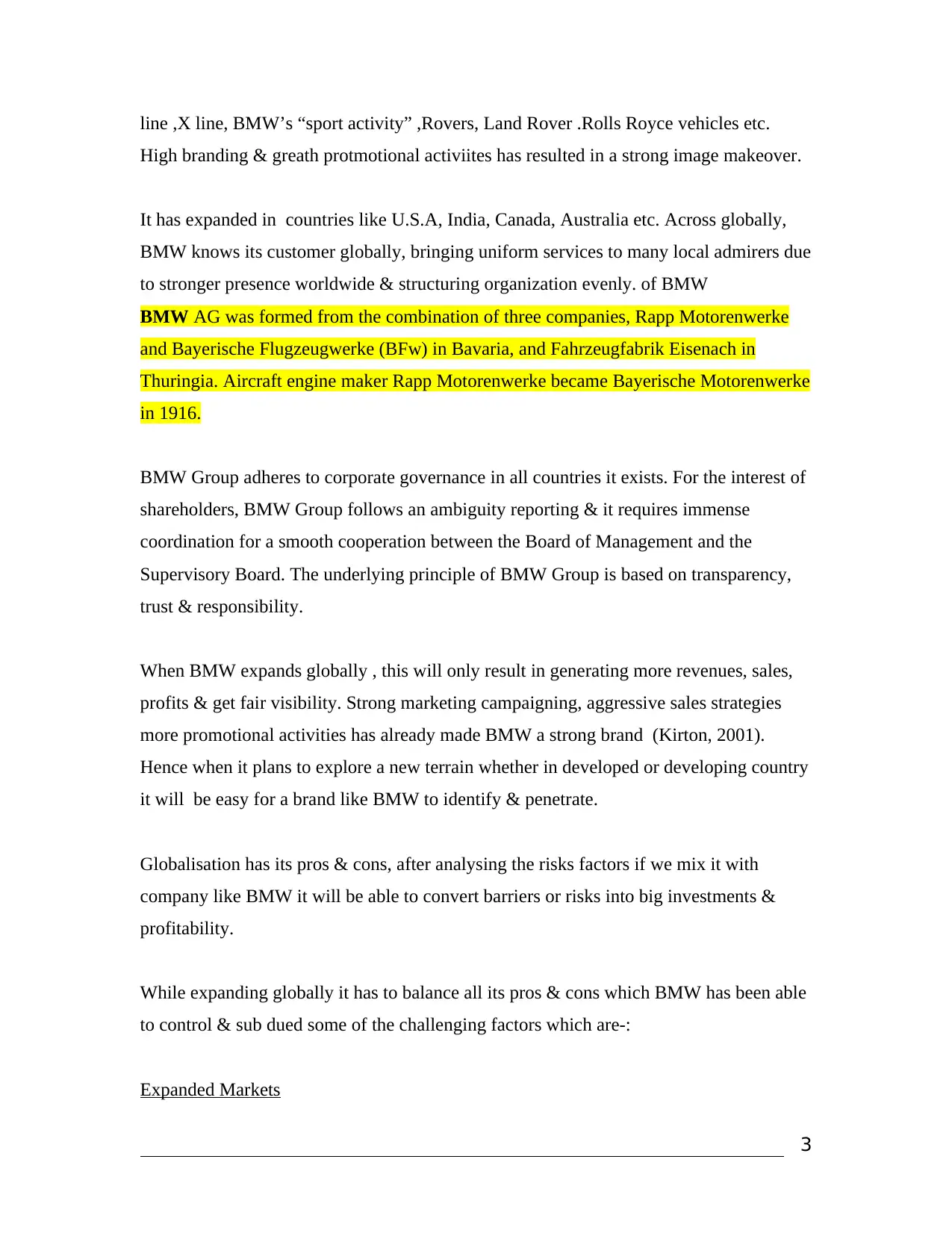
line ,X line, BMW’s “sport activity” ,Rovers, Land Rover .Rolls Royce vehicles etc.
High branding & greath protmotional activiites has resulted in a strong image makeover.
It has expanded in countries like U.S.A, India, Canada, Australia etc. Across globally,
BMW knows its customer globally, bringing uniform services to many local admirers due
to stronger presence worldwide & structuring organization evenly. of BMW
BMW AG was formed from the combination of three companies, Rapp Motorenwerke
and Bayerische Flugzeugwerke (BFw) in Bavaria, and Fahrzeugfabrik Eisenach in
Thuringia. Aircraft engine maker Rapp Motorenwerke became Bayerische Motorenwerke
in 1916.
BMW Group adheres to corporate governance in all countries it exists. For the interest of
shareholders, BMW Group follows an ambiguity reporting & it requires immense
coordination for a smooth cooperation between the Board of Management and the
Supervisory Board. The underlying principle of BMW Group is based on transparency,
trust & responsibility.
When BMW expands globally , this will only result in generating more revenues, sales,
profits & get fair visibility. Strong marketing campaigning, aggressive sales strategies
more promotional activities has already made BMW a strong brand (Kirton, 2001).
Hence when it plans to explore a new terrain whether in developed or developing country
it will be easy for a brand like BMW to identify & penetrate.
Globalisation has its pros & cons, after analysing the risks factors if we mix it with
company like BMW it will be able to convert barriers or risks into big investments &
profitability.
While expanding globally it has to balance all its pros & cons which BMW has been able
to control & sub dued some of the challenging factors which are-:
Expanded Markets
3
High branding & greath protmotional activiites has resulted in a strong image makeover.
It has expanded in countries like U.S.A, India, Canada, Australia etc. Across globally,
BMW knows its customer globally, bringing uniform services to many local admirers due
to stronger presence worldwide & structuring organization evenly. of BMW
BMW AG was formed from the combination of three companies, Rapp Motorenwerke
and Bayerische Flugzeugwerke (BFw) in Bavaria, and Fahrzeugfabrik Eisenach in
Thuringia. Aircraft engine maker Rapp Motorenwerke became Bayerische Motorenwerke
in 1916.
BMW Group adheres to corporate governance in all countries it exists. For the interest of
shareholders, BMW Group follows an ambiguity reporting & it requires immense
coordination for a smooth cooperation between the Board of Management and the
Supervisory Board. The underlying principle of BMW Group is based on transparency,
trust & responsibility.
When BMW expands globally , this will only result in generating more revenues, sales,
profits & get fair visibility. Strong marketing campaigning, aggressive sales strategies
more promotional activities has already made BMW a strong brand (Kirton, 2001).
Hence when it plans to explore a new terrain whether in developed or developing country
it will be easy for a brand like BMW to identify & penetrate.
Globalisation has its pros & cons, after analysing the risks factors if we mix it with
company like BMW it will be able to convert barriers or risks into big investments &
profitability.
While expanding globally it has to balance all its pros & cons which BMW has been able
to control & sub dued some of the challenging factors which are-:
Expanded Markets
3
Paraphrase This Document
Need a fresh take? Get an instant paraphrase of this document with our AI Paraphraser
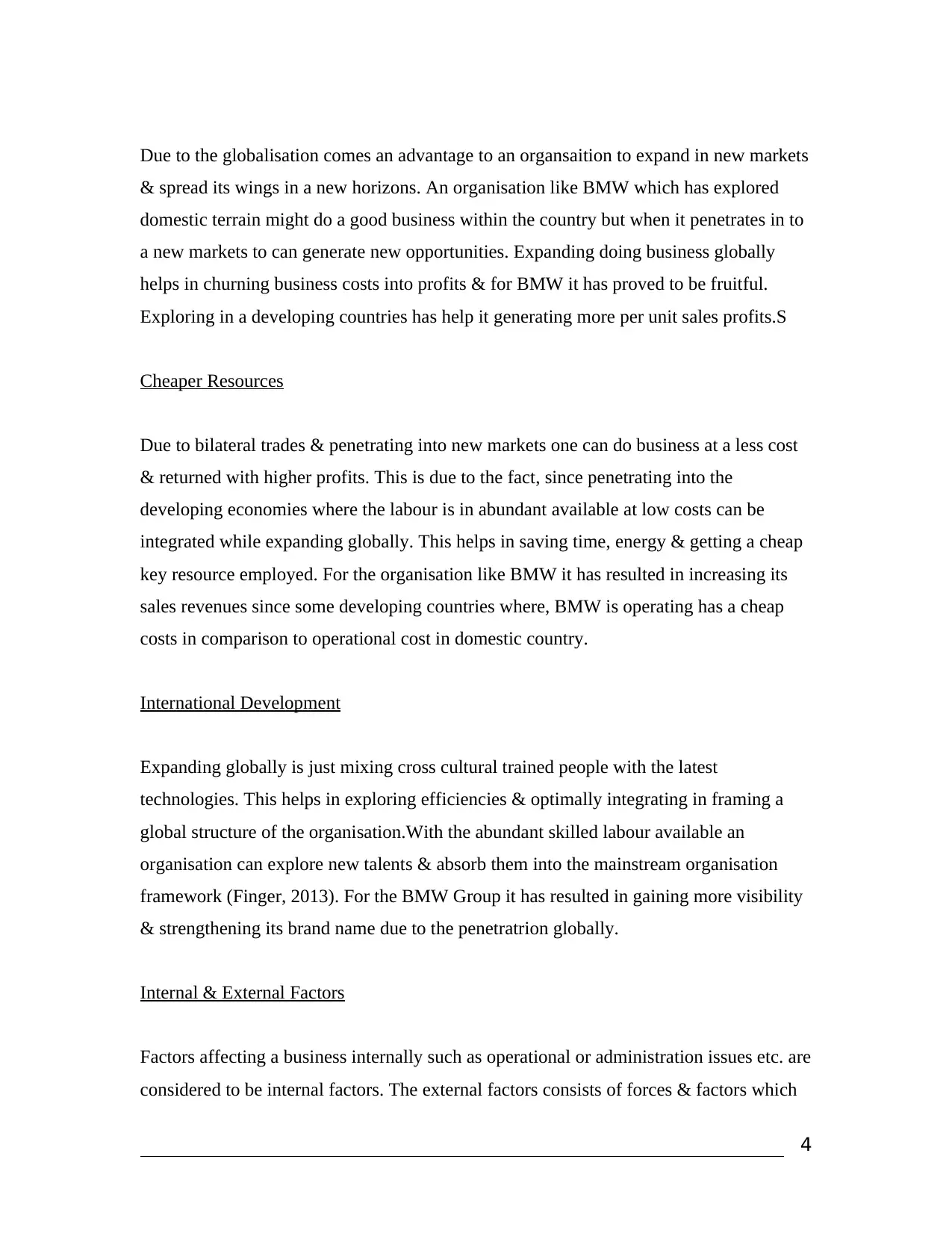
Due to the globalisation comes an advantage to an organsaition to expand in new markets
& spread its wings in a new horizons. An organisation like BMW which has explored
domestic terrain might do a good business within the country but when it penetrates in to
a new markets to can generate new opportunities. Expanding doing business globally
helps in churning business costs into profits & for BMW it has proved to be fruitful.
Exploring in a developing countries has help it generating more per unit sales profits.S
Cheaper Resources
Due to bilateral trades & penetrating into new markets one can do business at a less cost
& returned with higher profits. This is due to the fact, since penetrating into the
developing economies where the labour is in abundant available at low costs can be
integrated while expanding globally. This helps in saving time, energy & getting a cheap
key resource employed. For the organisation like BMW it has resulted in increasing its
sales revenues since some developing countries where, BMW is operating has a cheap
costs in comparison to operational cost in domestic country.
International Development
Expanding globally is just mixing cross cultural trained people with the latest
technologies. This helps in exploring efficiencies & optimally integrating in framing a
global structure of the organisation.With the abundant skilled labour available an
organisation can explore new talents & absorb them into the mainstream organisation
framework (Finger, 2013). For the BMW Group it has resulted in gaining more visibility
& strengthening its brand name due to the penetratrion globally.
Internal & External Factors
Factors affecting a business internally such as operational or administration issues etc. are
considered to be internal factors. The external factors consists of forces & factors which
4
& spread its wings in a new horizons. An organisation like BMW which has explored
domestic terrain might do a good business within the country but when it penetrates in to
a new markets to can generate new opportunities. Expanding doing business globally
helps in churning business costs into profits & for BMW it has proved to be fruitful.
Exploring in a developing countries has help it generating more per unit sales profits.S
Cheaper Resources
Due to bilateral trades & penetrating into new markets one can do business at a less cost
& returned with higher profits. This is due to the fact, since penetrating into the
developing economies where the labour is in abundant available at low costs can be
integrated while expanding globally. This helps in saving time, energy & getting a cheap
key resource employed. For the organisation like BMW it has resulted in increasing its
sales revenues since some developing countries where, BMW is operating has a cheap
costs in comparison to operational cost in domestic country.
International Development
Expanding globally is just mixing cross cultural trained people with the latest
technologies. This helps in exploring efficiencies & optimally integrating in framing a
global structure of the organisation.With the abundant skilled labour available an
organisation can explore new talents & absorb them into the mainstream organisation
framework (Finger, 2013). For the BMW Group it has resulted in gaining more visibility
& strengthening its brand name due to the penetratrion globally.
Internal & External Factors
Factors affecting a business internally such as operational or administration issues etc. are
considered to be internal factors. The external factors consists of forces & factors which
4
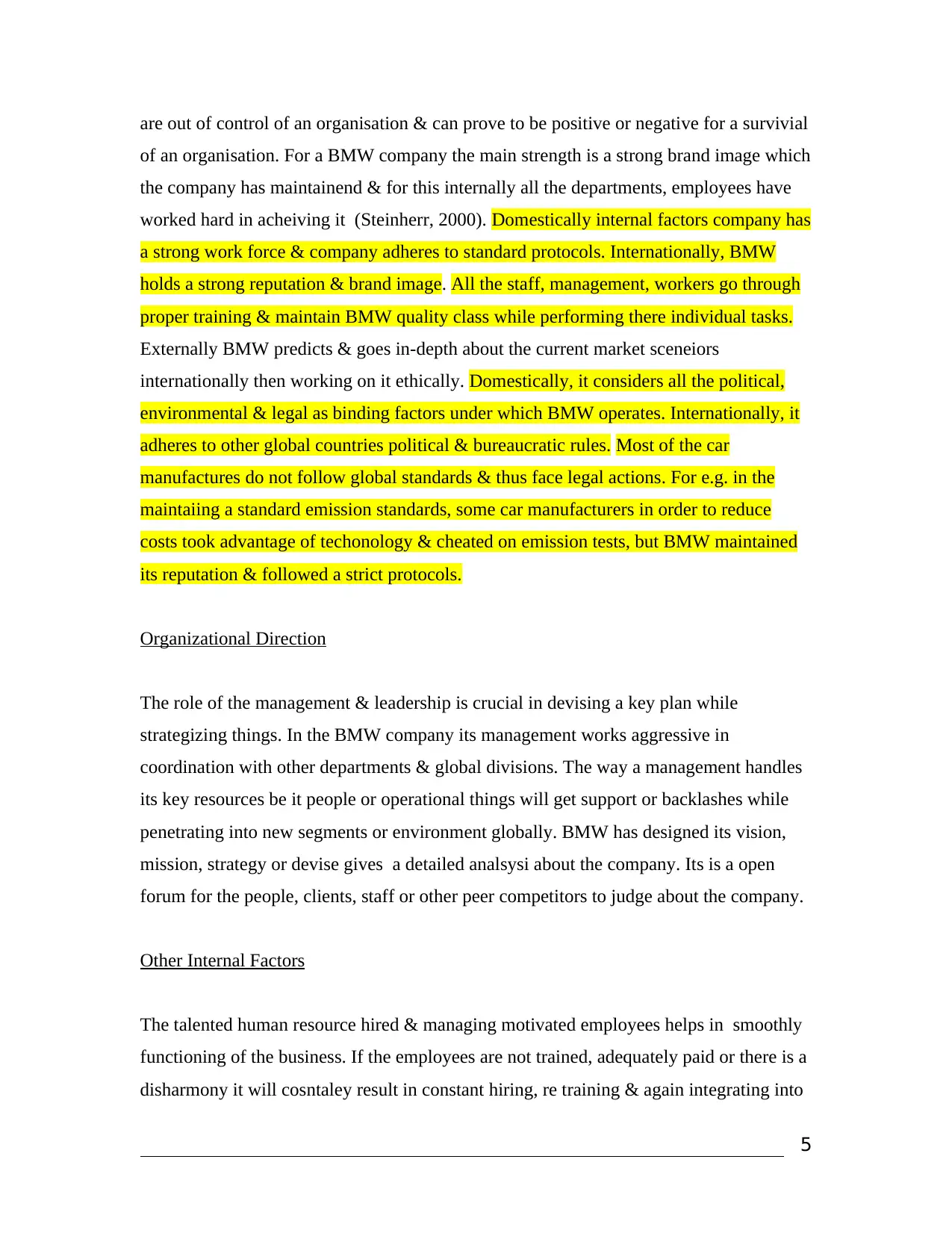
are out of control of an organisation & can prove to be positive or negative for a survivial
of an organisation. For a BMW company the main strength is a strong brand image which
the company has maintainend & for this internally all the departments, employees have
worked hard in acheiving it (Steinherr, 2000). Domestically internal factors company has
a strong work force & company adheres to standard protocols. Internationally, BMW
holds a strong reputation & brand image. All the staff, management, workers go through
proper training & maintain BMW quality class while performing there individual tasks.
Externally BMW predicts & goes in-depth about the current market sceneiors
internationally then working on it ethically. Domestically, it considers all the political,
environmental & legal as binding factors under which BMW operates. Internationally, it
adheres to other global countries political & bureaucratic rules. Most of the car
manufactures do not follow global standards & thus face legal actions. For e.g. in the
maintaiing a standard emission standards, some car manufacturers in order to reduce
costs took advantage of techonology & cheated on emission tests, but BMW maintained
its reputation & followed a strict protocols.
Organizational Direction
The role of the management & leadership is crucial in devising a key plan while
strategizing things. In the BMW company its management works aggressive in
coordination with other departments & global divisions. The way a management handles
its key resources be it people or operational things will get support or backlashes while
penetrating into new segments or environment globally. BMW has designed its vision,
mission, strategy or devise gives a detailed analsysi about the company. Its is a open
forum for the people, clients, staff or other peer competitors to judge about the company.
Other Internal Factors
The talented human resource hired & managing motivated employees helps in smoothly
functioning of the business. If the employees are not trained, adequately paid or there is a
disharmony it will cosntaley result in constant hiring, re training & again integrating into
5
of an organisation. For a BMW company the main strength is a strong brand image which
the company has maintainend & for this internally all the departments, employees have
worked hard in acheiving it (Steinherr, 2000). Domestically internal factors company has
a strong work force & company adheres to standard protocols. Internationally, BMW
holds a strong reputation & brand image. All the staff, management, workers go through
proper training & maintain BMW quality class while performing there individual tasks.
Externally BMW predicts & goes in-depth about the current market sceneiors
internationally then working on it ethically. Domestically, it considers all the political,
environmental & legal as binding factors under which BMW operates. Internationally, it
adheres to other global countries political & bureaucratic rules. Most of the car
manufactures do not follow global standards & thus face legal actions. For e.g. in the
maintaiing a standard emission standards, some car manufacturers in order to reduce
costs took advantage of techonology & cheated on emission tests, but BMW maintained
its reputation & followed a strict protocols.
Organizational Direction
The role of the management & leadership is crucial in devising a key plan while
strategizing things. In the BMW company its management works aggressive in
coordination with other departments & global divisions. The way a management handles
its key resources be it people or operational things will get support or backlashes while
penetrating into new segments or environment globally. BMW has designed its vision,
mission, strategy or devise gives a detailed analsysi about the company. Its is a open
forum for the people, clients, staff or other peer competitors to judge about the company.
Other Internal Factors
The talented human resource hired & managing motivated employees helps in smoothly
functioning of the business. If the employees are not trained, adequately paid or there is a
disharmony it will cosntaley result in constant hiring, re training & again integrating into
5
⊘ This is a preview!⊘
Do you want full access?
Subscribe today to unlock all pages.

Trusted by 1+ million students worldwide
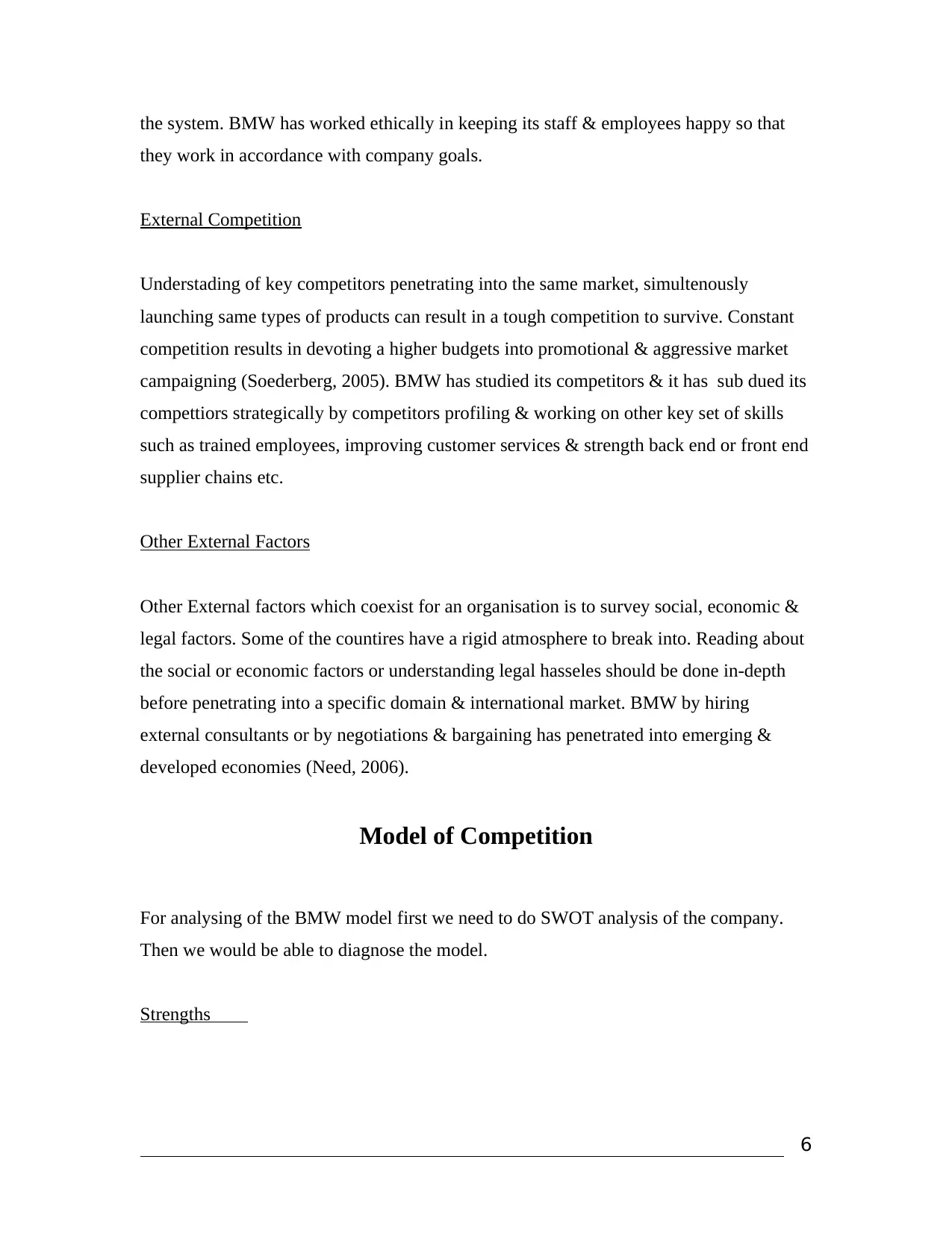
the system. BMW has worked ethically in keeping its staff & employees happy so that
they work in accordance with company goals.
External Competition
Understading of key competitors penetrating into the same market, simultenously
launching same types of products can result in a tough competition to survive. Constant
competition results in devoting a higher budgets into promotional & aggressive market
campaigning (Soederberg, 2005). BMW has studied its competitors & it has sub dued its
compettiors strategically by competitors profiling & working on other key set of skills
such as trained employees, improving customer services & strength back end or front end
supplier chains etc.
Other External Factors
Other External factors which coexist for an organisation is to survey social, economic &
legal factors. Some of the countires have a rigid atmosphere to break into. Reading about
the social or economic factors or understanding legal hasseles should be done in-depth
before penetrating into a specific domain & international market. BMW by hiring
external consultants or by negotiations & bargaining has penetrated into emerging &
developed economies (Need, 2006).
Model of Competition
For analysing of the BMW model first we need to do SWOT analysis of the company.
Then we would be able to diagnose the model.
Strengths
6
they work in accordance with company goals.
External Competition
Understading of key competitors penetrating into the same market, simultenously
launching same types of products can result in a tough competition to survive. Constant
competition results in devoting a higher budgets into promotional & aggressive market
campaigning (Soederberg, 2005). BMW has studied its competitors & it has sub dued its
compettiors strategically by competitors profiling & working on other key set of skills
such as trained employees, improving customer services & strength back end or front end
supplier chains etc.
Other External Factors
Other External factors which coexist for an organisation is to survey social, economic &
legal factors. Some of the countires have a rigid atmosphere to break into. Reading about
the social or economic factors or understanding legal hasseles should be done in-depth
before penetrating into a specific domain & international market. BMW by hiring
external consultants or by negotiations & bargaining has penetrated into emerging &
developed economies (Need, 2006).
Model of Competition
For analysing of the BMW model first we need to do SWOT analysis of the company.
Then we would be able to diagnose the model.
Strengths
6
Paraphrase This Document
Need a fresh take? Get an instant paraphrase of this document with our AI Paraphraser
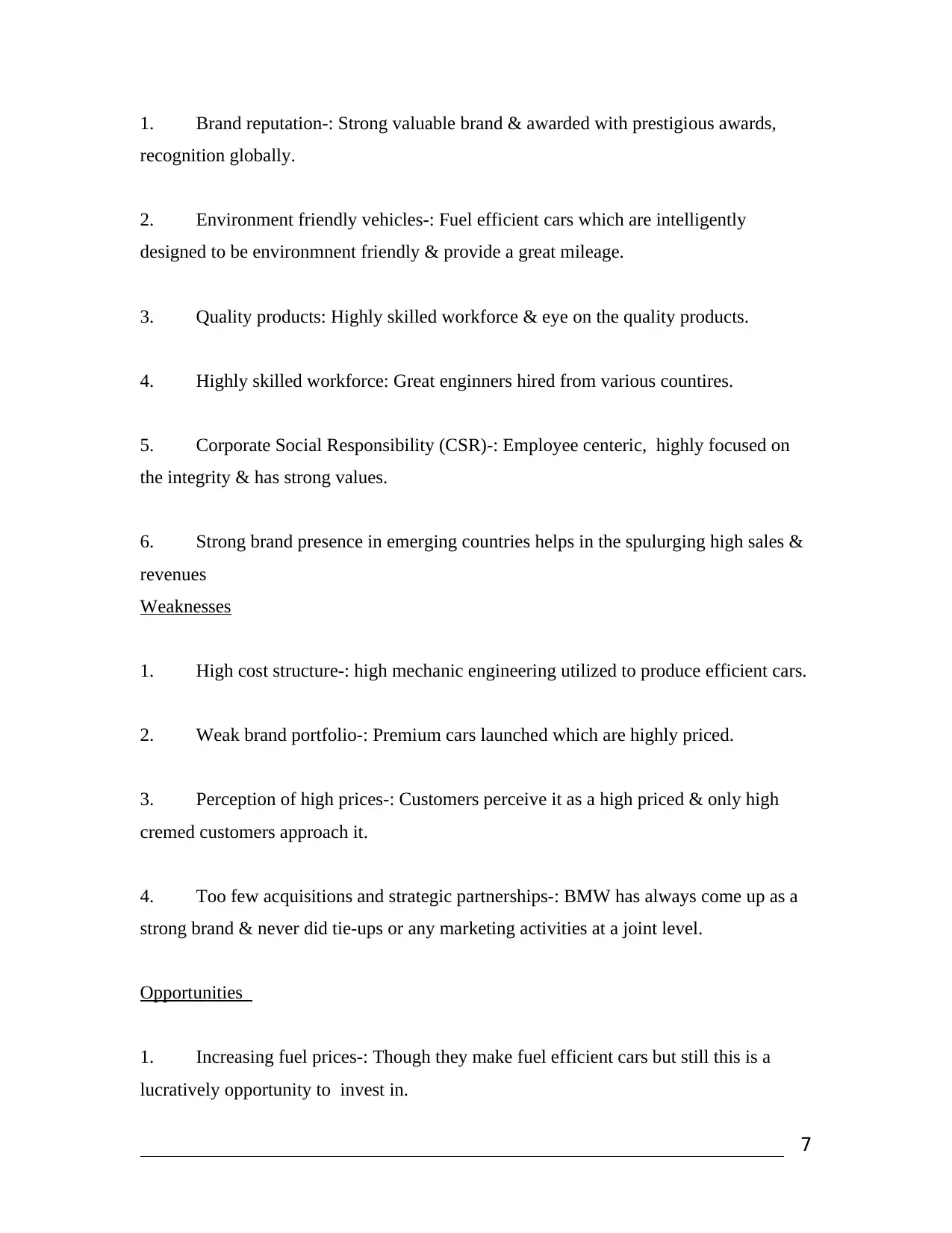
1. Brand reputation-: Strong valuable brand & awarded with prestigious awards,
recognition globally.
2. Environment friendly vehicles-: Fuel efficient cars which are intelligently
designed to be environmnent friendly & provide a great mileage.
3. Quality products: Highly skilled workforce & eye on the quality products.
4. Highly skilled workforce: Great enginners hired from various countires.
5. Corporate Social Responsibility (CSR)-: Employee centeric, highly focused on
the integrity & has strong values.
6. Strong brand presence in emerging countries helps in the spulurging high sales &
revenues
Weaknesses
1. High cost structure-: high mechanic engineering utilized to produce efficient cars.
2. Weak brand portfolio-: Premium cars launched which are highly priced.
3. Perception of high prices-: Customers perceive it as a high priced & only high
cremed customers approach it.
4. Too few acquisitions and strategic partnerships-: BMW has always come up as a
strong brand & never did tie-ups or any marketing activities at a joint level.
Opportunities
1. Increasing fuel prices-: Though they make fuel efficient cars but still this is a
lucratively opportunity to invest in.
7
recognition globally.
2. Environment friendly vehicles-: Fuel efficient cars which are intelligently
designed to be environmnent friendly & provide a great mileage.
3. Quality products: Highly skilled workforce & eye on the quality products.
4. Highly skilled workforce: Great enginners hired from various countires.
5. Corporate Social Responsibility (CSR)-: Employee centeric, highly focused on
the integrity & has strong values.
6. Strong brand presence in emerging countries helps in the spulurging high sales &
revenues
Weaknesses
1. High cost structure-: high mechanic engineering utilized to produce efficient cars.
2. Weak brand portfolio-: Premium cars launched which are highly priced.
3. Perception of high prices-: Customers perceive it as a high priced & only high
cremed customers approach it.
4. Too few acquisitions and strategic partnerships-: BMW has always come up as a
strong brand & never did tie-ups or any marketing activities at a joint level.
Opportunities
1. Increasing fuel prices-: Though they make fuel efficient cars but still this is a
lucratively opportunity to invest in.
7
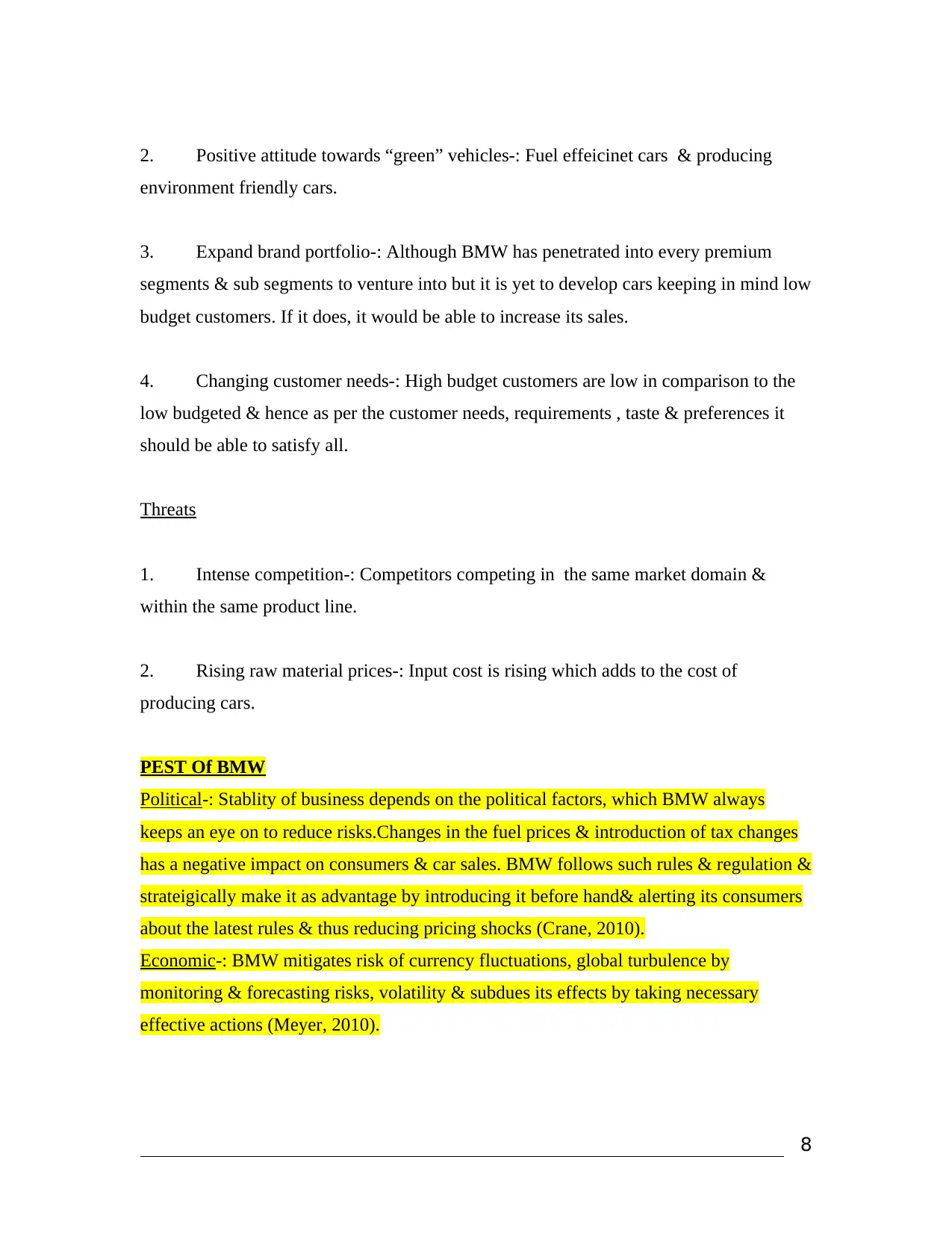
2. Positive attitude towards “green” vehicles-: Fuel effeicinet cars & producing
environment friendly cars.
3. Expand brand portfolio-: Although BMW has penetrated into every premium
segments & sub segments to venture into but it is yet to develop cars keeping in mind low
budget customers. If it does, it would be able to increase its sales.
4. Changing customer needs-: High budget customers are low in comparison to the
low budgeted & hence as per the customer needs, requirements , taste & preferences it
should be able to satisfy all.
Threats
1. Intense competition-: Competitors competing in the same market domain &
within the same product line.
2. Rising raw material prices-: Input cost is rising which adds to the cost of
producing cars.
PEST Of BMW
Political-: Stablity of business depends on the political factors, which BMW always
keeps an eye on to reduce risks.Changes in the fuel prices & introduction of tax changes
has a negative impact on consumers & car sales. BMW follows such rules & regulation &
strateigically make it as advantage by introducing it before hand& alerting its consumers
about the latest rules & thus reducing pricing shocks (Crane, 2010).
Economic-: BMW mitigates risk of currency fluctuations, global turbulence by
monitoring & forecasting risks, volatility & subdues its effects by taking necessary
effective actions (Meyer, 2010).
8
environment friendly cars.
3. Expand brand portfolio-: Although BMW has penetrated into every premium
segments & sub segments to venture into but it is yet to develop cars keeping in mind low
budget customers. If it does, it would be able to increase its sales.
4. Changing customer needs-: High budget customers are low in comparison to the
low budgeted & hence as per the customer needs, requirements , taste & preferences it
should be able to satisfy all.
Threats
1. Intense competition-: Competitors competing in the same market domain &
within the same product line.
2. Rising raw material prices-: Input cost is rising which adds to the cost of
producing cars.
PEST Of BMW
Political-: Stablity of business depends on the political factors, which BMW always
keeps an eye on to reduce risks.Changes in the fuel prices & introduction of tax changes
has a negative impact on consumers & car sales. BMW follows such rules & regulation &
strateigically make it as advantage by introducing it before hand& alerting its consumers
about the latest rules & thus reducing pricing shocks (Crane, 2010).
Economic-: BMW mitigates risk of currency fluctuations, global turbulence by
monitoring & forecasting risks, volatility & subdues its effects by taking necessary
effective actions (Meyer, 2010).
8
⊘ This is a preview!⊘
Do you want full access?
Subscribe today to unlock all pages.

Trusted by 1+ million students worldwide
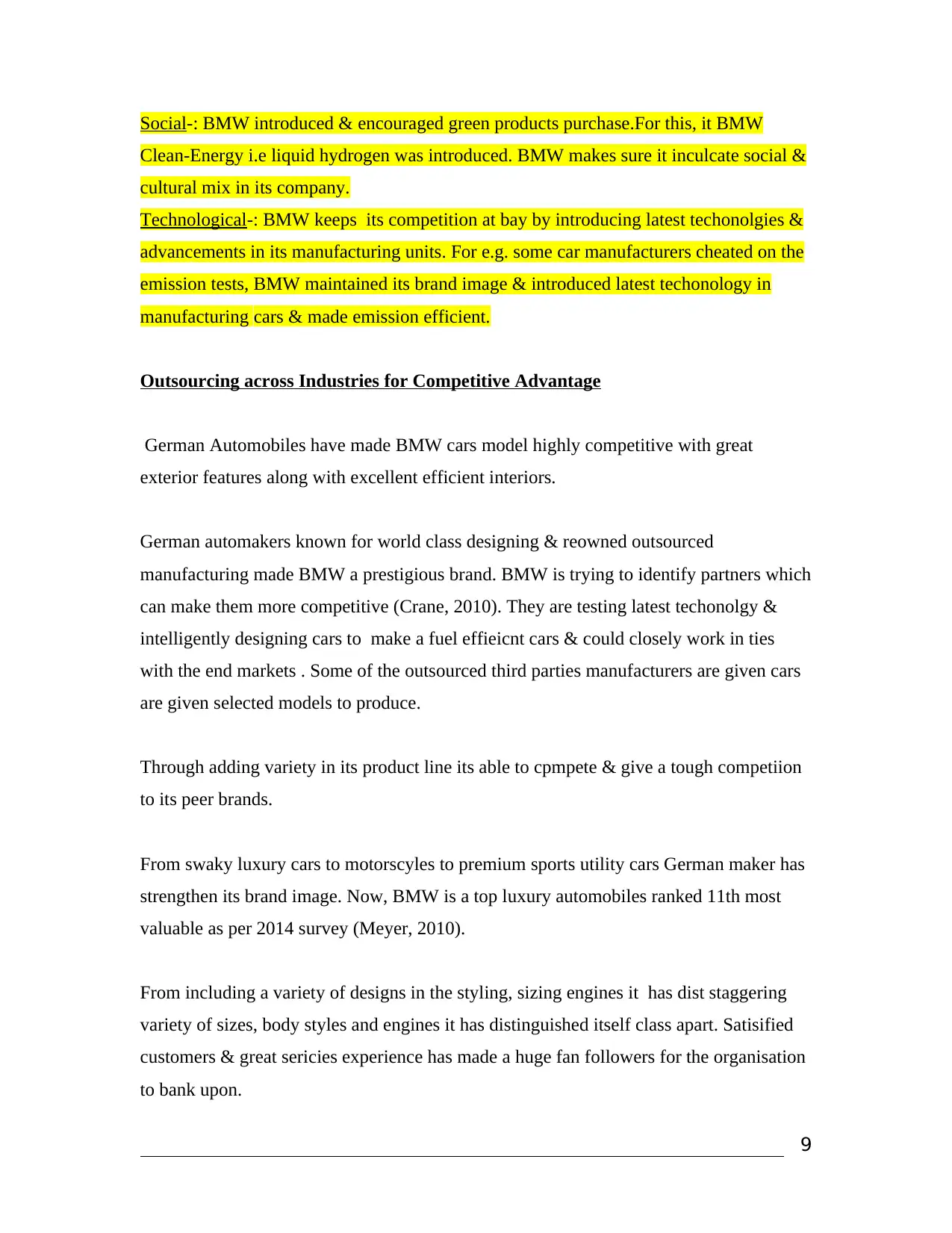
Social-: BMW introduced & encouraged green products purchase.For this, it BMW
Clean-Energy i.e liquid hydrogen was introduced. BMW makes sure it inculcate social &
cultural mix in its company.
Technological-: BMW keeps its competition at bay by introducing latest techonolgies &
advancements in its manufacturing units. For e.g. some car manufacturers cheated on the
emission tests, BMW maintained its brand image & introduced latest techonology in
manufacturing cars & made emission efficient.
Outsourcing across Industries for Competitive Advantage
German Automobiles have made BMW cars model highly competitive with great
exterior features along with excellent efficient interiors.
German automakers known for world class designing & reowned outsourced
manufacturing made BMW a prestigious brand. BMW is trying to identify partners which
can make them more competitive (Crane, 2010). They are testing latest techonolgy &
intelligently designing cars to make a fuel effieicnt cars & could closely work in ties
with the end markets . Some of the outsourced third parties manufacturers are given cars
are given selected models to produce.
Through adding variety in its product line its able to cpmpete & give a tough competiion
to its peer brands.
From swaky luxury cars to motorscyles to premium sports utility cars German maker has
strengthen its brand image. Now, BMW is a top luxury automobiles ranked 11th most
valuable as per 2014 survey (Meyer, 2010).
From including a variety of designs in the styling, sizing engines it has dist staggering
variety of sizes, body styles and engines it has distinguished itself class apart. Satisified
customers & great sericies experience has made a huge fan followers for the organisation
to bank upon.
9
Clean-Energy i.e liquid hydrogen was introduced. BMW makes sure it inculcate social &
cultural mix in its company.
Technological-: BMW keeps its competition at bay by introducing latest techonolgies &
advancements in its manufacturing units. For e.g. some car manufacturers cheated on the
emission tests, BMW maintained its brand image & introduced latest techonology in
manufacturing cars & made emission efficient.
Outsourcing across Industries for Competitive Advantage
German Automobiles have made BMW cars model highly competitive with great
exterior features along with excellent efficient interiors.
German automakers known for world class designing & reowned outsourced
manufacturing made BMW a prestigious brand. BMW is trying to identify partners which
can make them more competitive (Crane, 2010). They are testing latest techonolgy &
intelligently designing cars to make a fuel effieicnt cars & could closely work in ties
with the end markets . Some of the outsourced third parties manufacturers are given cars
are given selected models to produce.
Through adding variety in its product line its able to cpmpete & give a tough competiion
to its peer brands.
From swaky luxury cars to motorscyles to premium sports utility cars German maker has
strengthen its brand image. Now, BMW is a top luxury automobiles ranked 11th most
valuable as per 2014 survey (Meyer, 2010).
From including a variety of designs in the styling, sizing engines it has dist staggering
variety of sizes, body styles and engines it has distinguished itself class apart. Satisified
customers & great sericies experience has made a huge fan followers for the organisation
to bank upon.
9
Paraphrase This Document
Need a fresh take? Get an instant paraphrase of this document with our AI Paraphraser
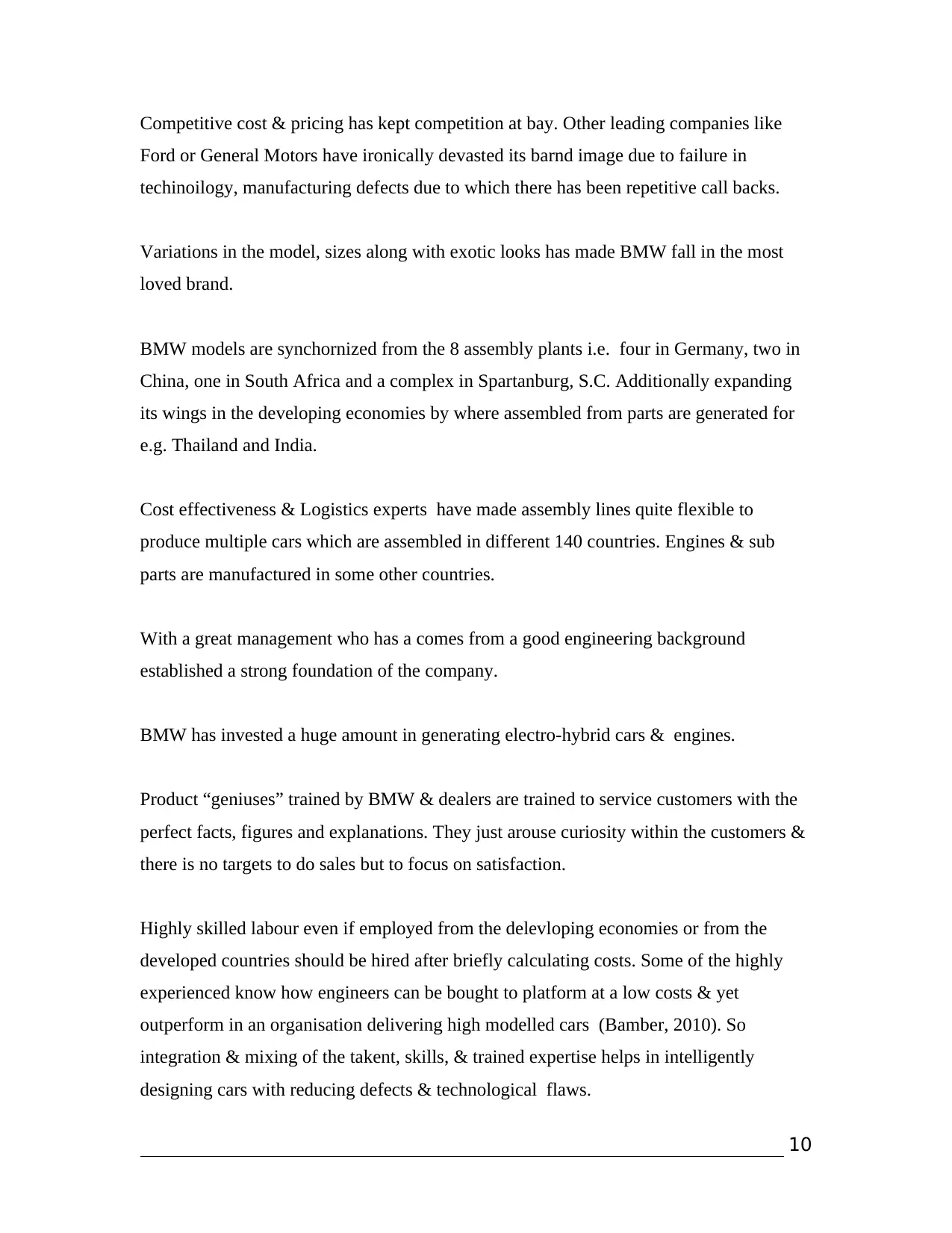
Competitive cost & pricing has kept competition at bay. Other leading companies like
Ford or General Motors have ironically devasted its barnd image due to failure in
techinoilogy, manufacturing defects due to which there has been repetitive call backs.
Variations in the model, sizes along with exotic looks has made BMW fall in the most
loved brand.
BMW models are synchornized from the 8 assembly plants i.e. four in Germany, two in
China, one in South Africa and a complex in Spartanburg, S.C. Additionally expanding
its wings in the developing economies by where assembled from parts are generated for
e.g. Thailand and India.
Cost effectiveness & Logistics experts have made assembly lines quite flexible to
produce multiple cars which are assembled in different 140 countries. Engines & sub
parts are manufactured in some other countries.
With a great management who has a comes from a good engineering background
established a strong foundation of the company.
BMW has invested a huge amount in generating electro-hybrid cars & engines.
Product “geniuses” trained by BMW & dealers are trained to service customers with the
perfect facts, figures and explanations. They just arouse curiosity within the customers &
there is no targets to do sales but to focus on satisfaction.
Highly skilled labour even if employed from the delevloping economies or from the
developed countries should be hired after briefly calculating costs. Some of the highly
experienced know how engineers can be bought to platform at a low costs & yet
outperform in an organisation delivering high modelled cars (Bamber, 2010). So
integration & mixing of the takent, skills, & trained expertise helps in intelligently
designing cars with reducing defects & technological flaws.
10
Ford or General Motors have ironically devasted its barnd image due to failure in
techinoilogy, manufacturing defects due to which there has been repetitive call backs.
Variations in the model, sizes along with exotic looks has made BMW fall in the most
loved brand.
BMW models are synchornized from the 8 assembly plants i.e. four in Germany, two in
China, one in South Africa and a complex in Spartanburg, S.C. Additionally expanding
its wings in the developing economies by where assembled from parts are generated for
e.g. Thailand and India.
Cost effectiveness & Logistics experts have made assembly lines quite flexible to
produce multiple cars which are assembled in different 140 countries. Engines & sub
parts are manufactured in some other countries.
With a great management who has a comes from a good engineering background
established a strong foundation of the company.
BMW has invested a huge amount in generating electro-hybrid cars & engines.
Product “geniuses” trained by BMW & dealers are trained to service customers with the
perfect facts, figures and explanations. They just arouse curiosity within the customers &
there is no targets to do sales but to focus on satisfaction.
Highly skilled labour even if employed from the delevloping economies or from the
developed countries should be hired after briefly calculating costs. Some of the highly
experienced know how engineers can be bought to platform at a low costs & yet
outperform in an organisation delivering high modelled cars (Bamber, 2010). So
integration & mixing of the takent, skills, & trained expertise helps in intelligently
designing cars with reducing defects & technological flaws.
10
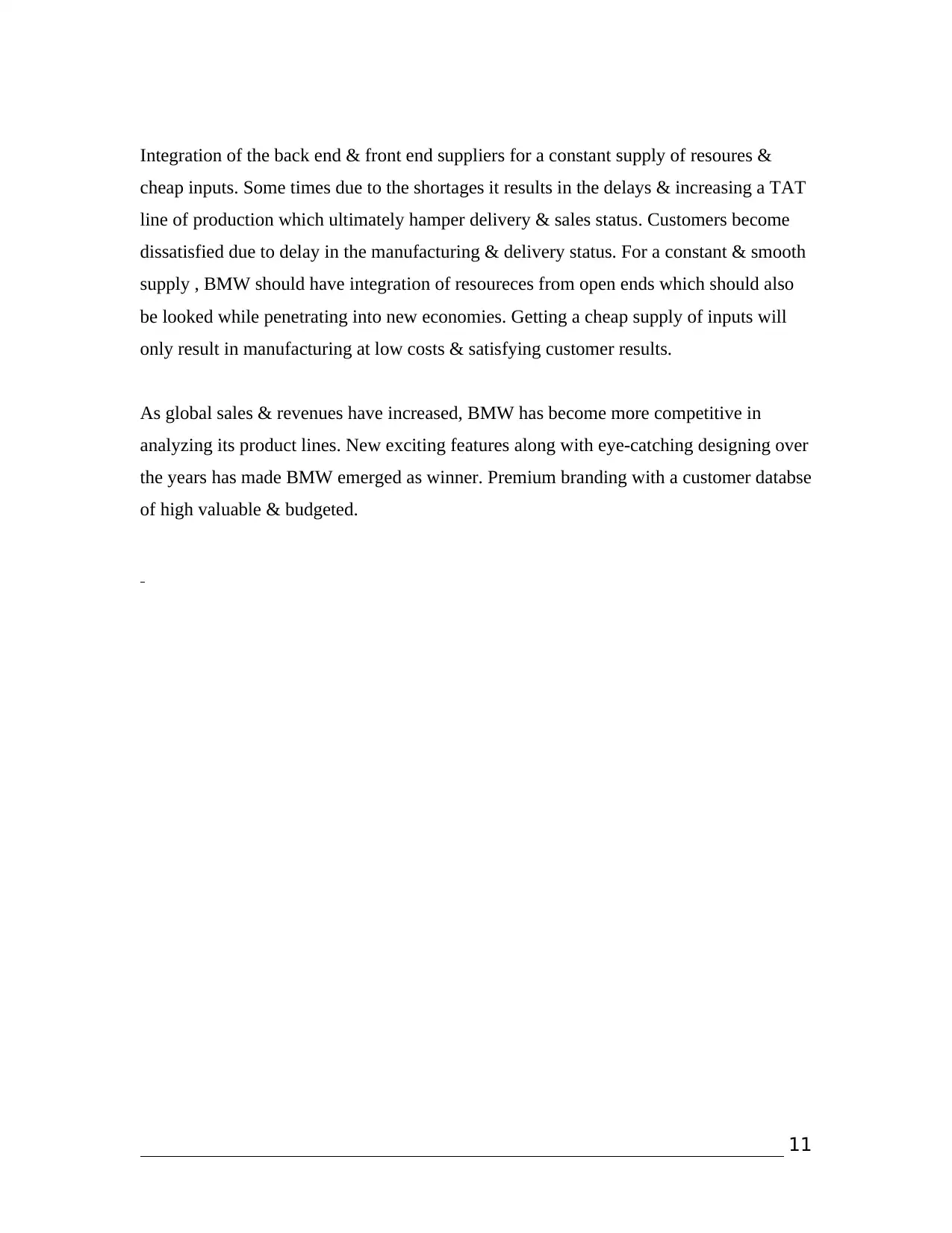
Integration of the back end & front end suppliers for a constant supply of resoures &
cheap inputs. Some times due to the shortages it results in the delays & increasing a TAT
line of production which ultimately hamper delivery & sales status. Customers become
dissatisfied due to delay in the manufacturing & delivery status. For a constant & smooth
supply , BMW should have integration of resoureces from open ends which should also
be looked while penetrating into new economies. Getting a cheap supply of inputs will
only result in manufacturing at low costs & satisfying customer results.
As global sales & revenues have increased, BMW has become more competitive in
analyzing its product lines. New exciting features along with eye-catching designing over
the years has made BMW emerged as winner. Premium branding with a customer databse
of high valuable & budgeted.
11
cheap inputs. Some times due to the shortages it results in the delays & increasing a TAT
line of production which ultimately hamper delivery & sales status. Customers become
dissatisfied due to delay in the manufacturing & delivery status. For a constant & smooth
supply , BMW should have integration of resoureces from open ends which should also
be looked while penetrating into new economies. Getting a cheap supply of inputs will
only result in manufacturing at low costs & satisfying customer results.
As global sales & revenues have increased, BMW has become more competitive in
analyzing its product lines. New exciting features along with eye-catching designing over
the years has made BMW emerged as winner. Premium branding with a customer databse
of high valuable & budgeted.
11
⊘ This is a preview!⊘
Do you want full access?
Subscribe today to unlock all pages.

Trusted by 1+ million students worldwide
1 out of 14
Related Documents
Your All-in-One AI-Powered Toolkit for Academic Success.
+13062052269
info@desklib.com
Available 24*7 on WhatsApp / Email
![[object Object]](/_next/static/media/star-bottom.7253800d.svg)
Unlock your academic potential
Copyright © 2020–2025 A2Z Services. All Rights Reserved. Developed and managed by ZUCOL.





